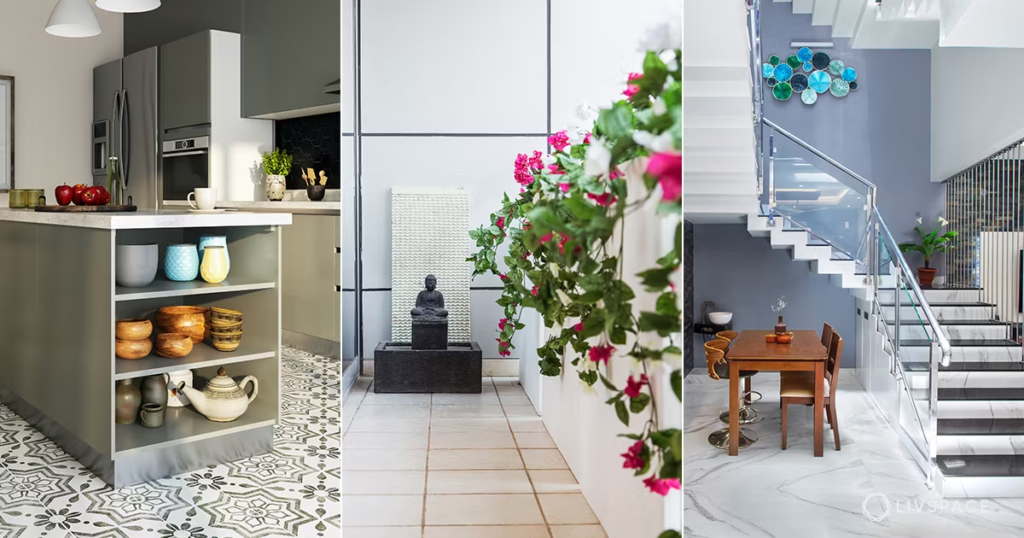
A wide range of flooring materials are available to homeowners, but tile has become the go-to option for many projects. That’s because tile offers a beautiful meeting ground of value and quality.
Unlike other surfaces, correctly manufactured tile is hard and impervious to moisture. It also requires only routine damp-mopping and periodic sealing of grout lines.
Natural Materials
Natural materials are a hot trend in today’s interior design. Natural materials have never been more popular, from quality wooden floors to stone slabs in the bathroom. This is probably the growing interest in sustainability and organic materials in general. Today’s consumers are more conscious of the environment than ever, and millennials are paving the way.
Tile is a hard-wearing, versatile material that can create various unique interior designs. It is available in all sorts of colors and patterns to suit any style of décor like the ones you can find at shops like Artistic Tile. It is also relatively inexpensive compared to materials such as marble and wood, making it a cost-effective option for those looking to transform their home.
Unlike carpets and wood, porcelain tiles do not retain dust, pet dander, and other allergens, contributing to poor air quality. Additionally, many tile options have antimicrobial properties to suppress and even destroy harmful microorganisms, including mold spores.
In addition, porcelain tiles are often free of formaldehyde, a chemical known to irritate the skin, nose, throat, and lungs. They can also help to moderate temperature fluctuations, which reduces energy costs and emissions. Many tile manufacturers also recycle their waste and use eco-friendly glazes. This makes them an excellent choice for those pursuing the Living Building Challenge or other environmental certifications.
Cleanliness
Unlike wood or carpet, tile is impervious to moisture and mildew. It’s also a good choice for hygienic applications, such as kitchen floors where food is prepared and consumed.
The tile’s durability and impervious surface make cleaning easy with a simple mop and water. It’s also non-toxic and doesn’t emit harmful fumes when burned. In addition, it doesn’t contain polyvinyl chloride (PVC) or organotins, the toxic compounds found in many vinyl products.
The ceramic material that tiles are made from is naturally occurring and doesn’t leach toxins into the environment or decompose in landfills. That’s one reason it qualifies as “clean fill” for disposal at the end of its long life cycle.
A growing trend in home renovations is utilizing large-format tile for walls and floors. This eliminates the seams where grout lines normally appear and creates a harmonious space.
Historically, one style of tile was chosen for walls and another for floors. But manufacturers make their products suitable for both surfaces as the large-format trend grows.
For example, porcelain tiles that are 2cm thick can be used outside as well as indoors, making them a great option for patios and outdoor spaces. The new products can withstand cold temperatures and be used year-round. Additionally, they are lighter in weight than traditional porcelain and don’t require as much cement for installation.
Durability
As tile manufacturers continue to push the envelope in their design capabilities, they’re also increasing durability. Tiles with denser surfaces, like porcelain and some ceramic, inherently have greater breaking strength and water absorption than their predecessors, making them ideal for heavy-traffic areas. New technologies allow for fine texture and more realistic graphics on surfaces that are easier to clean—for example, a new reactive ink that puffs up during firing to produce intricate designs on thin tiles with impressive detail.
Some of the most durable floor tile currently on the market is manufactured from concrete, which offers natural durability and beauty at a much lower cost than wood or stone. Manufacturers are introducing wood-inspired concrete products with grain patterns that resemble real wood and new color schemes like black and white. For instance, the Industrial collection reinterprets cement in large-format slabs that limit grout lines and create a cohesive look. In addition, new lightweight mortars allow installers to handle these larger sizes with ease. This makes these products viable for homeowners who want to save on installation costs.
Versatility
Many new tile materials offer design versatility that can be used for several applications. These include larger formats, textured surfaces, and eco-friendly qualities. These innovations can be used for backsplashes, showers, and flooring, as well as for wall cladding and exterior panels.
One of the biggest trends in the tile industry this year is a focus on natural colors and finishes. These hues range from earthy jewel tones like amber and brick to leafy greens and clay shades that offer a sense of connection to the outdoors.
In addition, manufacturers are creating ceramic and porcelain tiles with a three-dimensional look. This can be accomplished through textures with divots and grooves that provide depth or relief work to add texture and visual interest. The effect is stunning and dramatic, especially on walls where the dimension accentuates a room’s décor. On floors, however, the 3-D look could create a trip hazard, and cleanability is also a factor since grooves and dents tend to attract dirt.
Another big trend in the tile industry is blurring lines between commercial and residential collections. While distributors have a heavier weighting toward the commercial market, most manufacturers produce and stock collections that can be installed on both floor and wall. This means that homeowners can select the tile that best suits their room’s personality rather than sticking with a commercial or residential product.